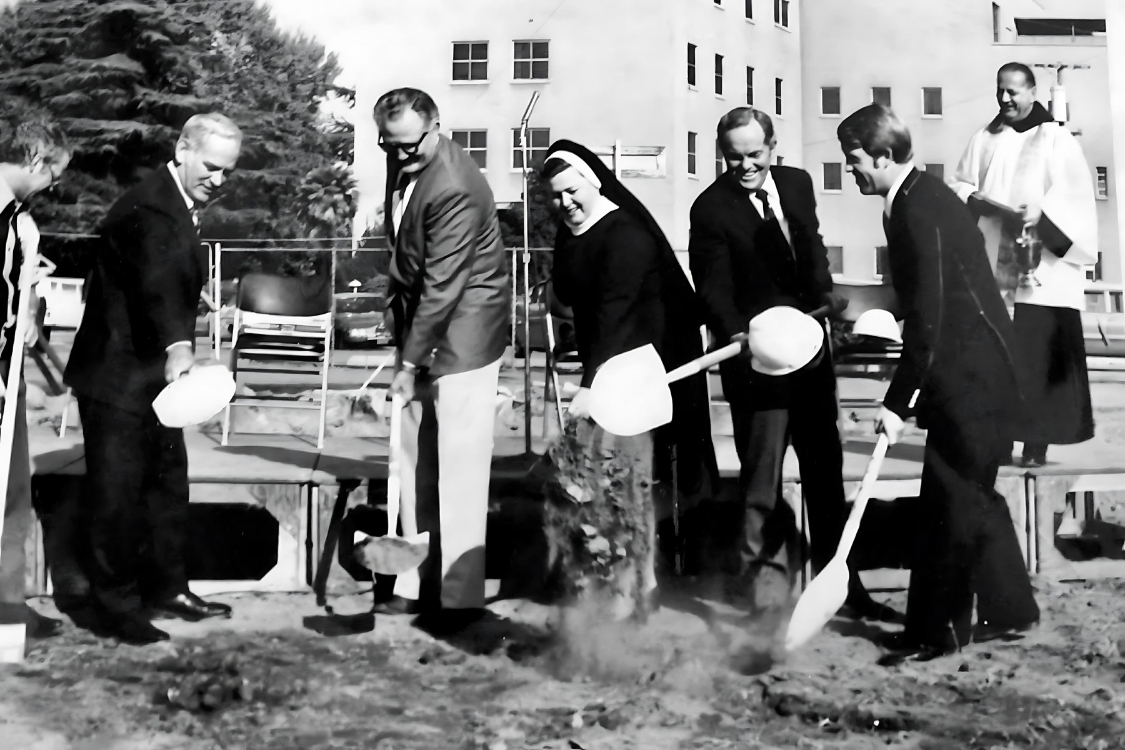From Dublin to Bakersfield
The Enduring Legacy of the Sisters of Mercy and Mercy Hospital

Groundbreaking at Mercy Hospital Downtown circa 1950s
The Sisters of Mercy, a Catholic religious congregation, trace their beginnings to Dublin, Ireland, where the compassionate and visionary Catherine McAuley changed countless lives. In 1822, Catherine inherited what would now be a fortune—about $500,000—from a couple she had served loyally for nearly two decades. Rather than seeking comfort or luxury, she took a bold step: Catherine used her inheritance to build the very first House of Mercy on Baggot Street in 1827. This sanctuary quickly became a lifeline and a beacon of hope for poor women and girls, offering them safety, education, and a chance at a brighter future.
The Archbishop of Dublin, deeply moved by Catherine’s tireless efforts, urged her to form a new religious congregation. At that time, it was unheard of for religious women to step outside the cloistered walls of a convent. But Catherine was determined to break the mold—as she wanted to “walk among the sick and the poor.” Thus, the Sisters of Mercy were born, quickly earning the nickname “the walking nuns.” Unlike other congregations, the Sisters of Mercy embraced a unique fourth vow: service to others. This commitment set them apart, fueling their mission to bring mercy and compassion directly to those who needed it most.
The Sisters of Mercy wasted no time in expanding their reach, dedicating themselves to caring for the sick and educating the underserved. By the time Catherine McAuley passed away in 1841, nearly 15 vibrant communities had sprung up across Ireland and England. Their spirit of service was contagious—the congregation’s influence soon stretched across the globe, leaving a trail of hope wherever the Sisters went.
Renowned for their pioneering spirit, the Sisters of Mercy established hospitals and schools in the areas of most desperate need. When they arrived in San Francisco in 1854, the city was in crisis—outbreaks of cholera, typhoid, and influenza threatened countless lives. Without hesitation, the Sisters rolled up their sleeves, nursing the sick and comforting the fearful. Their efforts led to the founding of St. Mary’s Hospital, which proudly stands as San Francisco’s oldest continuously operating hospital—a living testament to the Sisters’ quick action, compassion, and lasting impact on healthcare in the city.
Bakersfield’s Mercy Hospital owes its existence to the unwavering commitment and compassion of the Sisters of Mercy. The dream began when parishioners from Saint Francis Church—led by the determined William Howell—petitioned the Archbishop of Los Angeles for help to bring a Catholic hospital to their thriving agricultural community. On a chilly February morning in 1910, four brave young Sisters of Mercy stepped off the train and made their way to the humble St. Clair House at H and 16th Streets. With them, they carried not only medical skill and nursing knowledge, but also an unshakable philosophy of dignity, respect, and holistic healing. It didn’t take long for the Sisters to realize that the little house could not keep pace with Bakersfield’s rapid growth. Undaunted, they resolved to build a modern hospital that would truly serve the needs of their community.
Their dreams received an extraordinary boost from an act of remarkable generosity. William de Gana, a devoted St. Francis Church parishioner, stepped forward with a gift that made it possible for the Sisters to build an “up-to-date hospital worthy of the best interests of Bakersfield.” His only request: anonymity until after his passing. With this gift, the original hospital moved to the Truxtun site, and construction began on the new Mercy Hospital—a $41,000 endeavor that still stands today as Mercy Hospital Downtown, a monument to faith and community spirit.
Local architect Orville Lee Clark poured his heart into designing Mercy Hospital. According to historical records, he spent two months traveling across the United States, seeking out the most innovative hospital designs. When Mercy Hospital opened its doors, it was a marvel: the city’s first passenger elevator, illuminated signal lights above every doorway, and two of the most advanced operating rooms in California. The Bakersfield Californian gushed in April 1914 that it was “unquestionably one of the finest buildings in Bakersfield and is a great moment to the city as well as to the gentle Sisters and Catholic church.” Towering above it all was a stunning 70-foot dome, crowned by a gold-leaf cross that glowed from within—a “beacon of light” visible for ten miles, symbolizing hope and healing for all who saw it.
Disaster struck in 1952 when a massive earthquake centered in Tehachapi devastated much of the Mercy Hospital campus. As the dust settled, the Greater Bakersfield Memorial Committee was already fundraising for a new hospital, but the need became even more urgent. Community leaders, galvanized by Ralph Smith and joined by the Sisters of Mercy, launched a spirited campaign to secure matching federal funds. During this time of uncertainty and hope, Sister Mary Petra, the hospital’s administrator, offered words of faith and encouragement: “The Sisters have been united in prayer for the success of the Mercy-Memorial Drive and its benefactors and promoters. We shall continue to pray that God will bless our united efforts to give the people of this area hospitals in which prodigies of modern medical science can be realized.”
As Bakersfield expanded, Mercy Hospital grew right along with it. The downtown facility expanded to accommodate 144 beds, ensuring more families could receive care close to home.